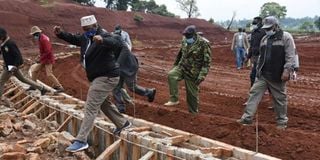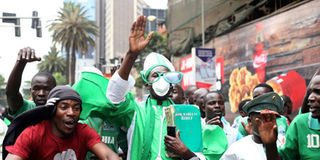Breaking News: Ruto postpones school reopening indefinitely due to flooding
Why Tanzanian football will grow and Kenya’s will not

Bongo star artist Diamond Platnumz (shirtless) entertains Simba fans with club owner Mohammed Dewji in tow during a colourful ceremony dubbed "Simba Day" at the Benjamin Mkapa Stadium in Dar es Salaam on August 22, 2020.
What you need to know:
- Investment in sports Tanzania will soon attract the heaviest artillery from West Africa while Kenya will continue to remain a big talent graveyard. Taifa Stars won’t become a top national team soon but clubs like Simba will
- The contrast between the two countries is as stark as day and night. Kenya is grappling with a crises of item one of all the basic things needed to be able to play football: lack of playing surfaces. Meanwhile, down south, sights have been set on the Africa Champions League – and the leaders there are dead serious about it
If anyone had any doubts that Kenya football is on its deathbed while that of our neighbours in Tanzania is headed for the stratosphere, last Saturday’s Simba Day celebrations were your answer.
The contrast between the two countries is as stark as day and night. Kenya is grappling with a crises of item one of all the basic things needed to be able to play football: lack of playing surfaces. Nation Sport has beaten this subject to pulp but it still bears repeating.

Sports Chief Administrative Secretary Noor Hassan Noor (left), accompanied by Athletics Kenya President Rtd. Major Gen. Jack Tuwei right), and other officials during a visit at Kamariny Stadium in Iten, Elgeyo-Marakwet County on July 18, 2020, to check on a return to work formula for the construction of the stadium which stalled in 2017.
Across the country, our youth use cratered fields because they have no choice. They have come to accept that this enforced self-violence, this invitation to serious injury which guarantees a short career, is normal life.
Meanwhile, down south, sights have been set on the Africa Champions League – and the leaders there are dead serious. Amid the gargantuan celebrations at Dar es Salaam’s Benjamin Mkapa Stadium, Simba owner Mohammed Dewji declared:
"I am not satisfied with only domestic success. My target is the African championship. Our main aim is to continue fighting and competing for the Champions League title. But reaching the group stage of the competition is, of course, our first priority.”
These are not hollow words, like the ones that promised Kenyans eight world-class stadiums in four years two General Election campaigns ago. Those were just phantoms, as we have since learnt the hard way. Tanzania’s wealthiest man has the means, the will and the focus to get his vision accomplished.
Among the shining tools in his box are our own Joash Onyango, formerly of Gor Mahia, and whose defensive capabilities earned him the sobriquet Berlin Wall – not exactly the best of nicknames but which nonetheless adequately forewarns on-coming forwards the kind of opponent they are up against.

Former Gor Mahia defender Joash Onyango when he was unveiled by Simba SC at Benjamin Mkapa Stadium in Dar es Salaam before the friendly tie against Vital'O of Burundi on August 22, 2020.
In short order, Onyango became Simba’s Catch Number 3 from our struggling eternal champions. He follows former teammates Francis Kahata and Meddie Kagere into the lion’s den.
I followed Saturday’s developments with keen interest and, yes, some emotion. They reminded me of a question I was asked in an NTV panel discussion on Kenya sport.
The personable anchor, Mark Masai, asked me whether I missed my reporting days. I told him that I didn’t; that I had long moved on.
But after watching the charged atmosphere, whose energy I could feel from all 800 kilometres away, I felt a change of heart even if I knew, deep down, that it was a passing feeling. I felt the urge to get up close with those people and ask them what made them so happy.

Former Gor Mahia defender Joash Onyango when he was unveiled by Simba SC at Benjamin Mkapa Stadium in Dar es Salaam before the friendly tie against Vital'O of Burundi on August 22, 2020.
I wanted to ask them why they thought a raging virus shouldn’t be allowed to get in the way of celebrating their club. They were living their life today while the future would take care of itself. What did they know that I didn’t?
I watched Bongo star Diamond Platnumz land in his helicopter, elegantly emblazoned Simba Day, and work the crowd to a frenzy. I saw the club owner taking off his jersey and running around bare-chested, waving the shirt to the crowd as if he was one of the players and I thought: this is one of Africa’s richest men? Well, he is obviously not Kenyan otherwise he wouldn’t be behaving like those holloi polloi...
And finally I saw Simba maul Burundi’s Vital’O 6-0 with Onyango a real wall in the Reds rearguard. I think signing him up was an inspired decision. What a day to cut through these gloomiest of times that we are living through! Thank you, Simba Sports Club, and Godspeed in your African journey.

To become a football power, you need one of two things because, for some reason, it has proved difficult to have both. You need to have plenty of natural talent or the capacity to manufacture it from within your young people.
Examples of countries that have excelled with natural talent are Brazil and Argentina in South America and Cameroon, Ghana and Nigeria in Africa. Examples of countries that have manufactured great footballers out of ordinary ones using science and imaginative use of financial and managerial resources are Germany and Italy in Europe and Egypt, Morocco and Algeria in Africa.
The talent that abounds in the richly-endowed countries mentioned above stands them in good stead even if their game is mismanaged by corrupt officials, especially in the case of Africa.
Players in these countries have given a superlative account of themselves in the world stage even as their money is stolen by rapacious officials.
Countries without great natural talent have no choice but to be very good managers of people and material resources. Otherwise, failure is guaranteed. The two different scenarios we are seeing in Kenya and Tanzania are a good illustration of this argument.

Simba SC defender Joash Onyango (left) vies for the ball with KMC's Salim Aye during their friendly match at the National Stadium in Dar es Salaam on August 26, 2020.
Both countries don’t have an abundance of talent as in the case of the West African region. But Tanzania is already becoming a success while Kenya is a disaster.
If things remain constant, Tanzania will soon attract the heaviest artillery from West Africa while Kenya will continue to remain a big talent graveyard.
Tanzania’s top clubs will in a few years to come change the African football landscape and start winning the top trophies. Taifa Stars won’t become a top national team any time soon but clubs like Simba will.
Both countries’ football scene is a chip off the national character. What are the main differences between the two countries? Let’s summarise them:
Kenya: Kenyans have a haughty attitude towards their neighbours. They are loud and are afflicted with a superiority complex. So ingrained is this in their character that they are not even aware that the cheese moved a long time ago and now it is they who must play catch up.
They can’t organise a small tournament like the African Nations Championship which a country like Rwanda, which suffered a catastrophic genocide a little over two decades ago, can do with eyes shut.
This delusionary state stops Kenyans from seeing that endemic corruption has all but put paid to any chances they ever had of building a great society. Kenya’s waters are full of big sharks and a myriad piranhas, all devouring one another while praying loudly.
In 1974, Simba Sports Club became the first club to win the reinstated East and Central Africa Club championship. On getting confirmation that the tournament would be held, Mr Peter Shiyukah, chairman of Kenya champions Abaluhya, told the media on January 5, 1974:
“Now that we have been informed that the tournament is definitely on, the team is going into serious training as well as trying to raise funds towards the cost of travelling to Dar for the East African Club championship and also to the other countries that we will travel to for the African Club Cup.”
Four years later as Gor Mahia prepared to play Guinea’s Horoya in the semi-final of the Africa Cup Winners Cup, club vice-chairman David Opar told the country that they had exhausted all their resources and were now appealing for donations from well-wishers to help the team meet its national obligation. Frantic fundraising took place and the team mercifully made it to the final.
Today, the two teams are in the same fix, a whopping 46 years later in the case of AFC Leopards. Meanwhile, with no need to engage in desperate harambees, Simba is turning Gor Mahia into its nursery. But if you listened only to the Kenyan side of this equation speaking, you might think the situation is the other way round.

Gor Mahia fans dance along Kimathi street in Nairobi ahead of Mashemeji Derby against AFC Leopards on March 8, 2020.
Tanzania: The national character is marked by a humility that is easily upset by a visitor’s abrasiveness. Such abrasiveness, which as expected fails to notice an underlying deep personal and national pride – as opposed to tribal affiliation - elicits resentment and a desire to teach the other good manners.
It is hard for a person who in the main is accustomed to hearing only his own voice to get along with another one who is open minded. That is why Kenyans and Tanzanians have a lot of problems getting along.
In 2010, Kenya changed the way it is governed. It adopted a new constitution, the hallmark of which is devolution of political authority to entities known as counties. It is a well-crafted document and if that is all that was needed, its promulgation in Uhuru Park would have marked the day we entered heaven. But things don’t work like that.
The devil is in its implementation. If you speak to the Kenyan in the street today, one of the first things you will hear is that they just devolved corruption from Nairobi to the grassroots. What about getting anything done? Do you know how long they have been trying to renovate Nyayo National Stadium? Four years! This is enough time for some people to knock down the entire edifice and build a new one.
And Kasarani? Kenya’s version of England’s Wembley or Brazil’s Maracana was closed for a long time for renovations. But when it was reopened a leak from its roof could have competed with Nyahururu Falls for ferocity.

A wide view of Moi International Sports Centre, Kasarani as at May 6, 2020.
Kenya’s 2010 constitution is a well-meaning document that tries to prevent public money from being stolen by its custodians. What, in reality, it created is a hydra-headed bureaucratic beast whose wheels turn extremely slowly.
Its tortuous course starts in government offices and winds through the private sector before making stopovers in courts where it could be ordered to return to the source and the process starts all over again.
Or it could proceed to town halls for mandatory public participation. There, the people’s in-put might result in the whole enterprise being unrecognizably altered.
By the time all this is done, the completed project will almost certainly be sub-standard, years behind schedule and millions of shillings over budget. Without intending it, the new constitution has become a mediocrity manufacturing plant.
The dozens of stadiums around the country whose work has stalled and have overgrown bushes on the concrete are in one or the other of these bureaucratic stations. To move just one simple step requires humongous amounts of energy and time. But we are the ones who do the sneering at our East African compatriots.
Kenya is like a car stuck in mud, digging itself in the exact same spot, going nowhere. It can finish everything – tyres, fuel, coolant, clutch if it is a manual one and whatnot.
Meanwhile, nobody in the vicinity can get anything done because of the noise it is making. And those around it keep getting dirtier. But during all this time, the loudest know-it-all is the driver.





